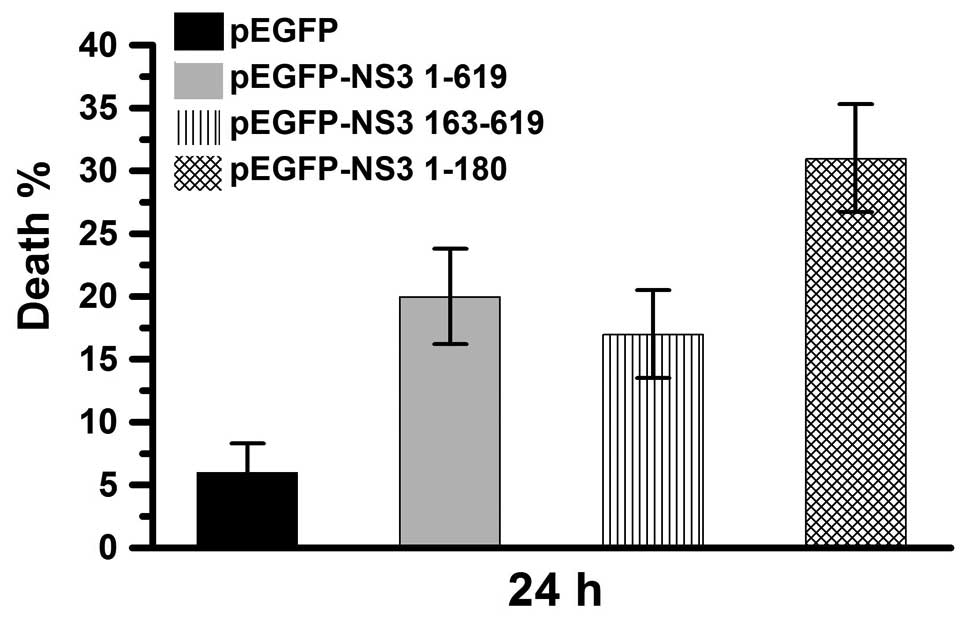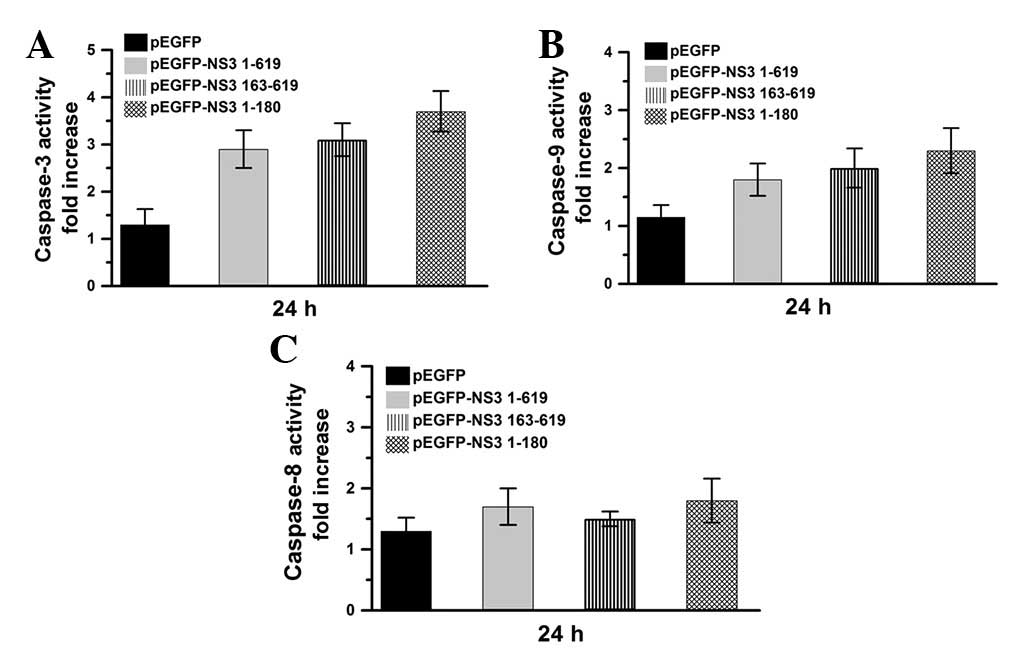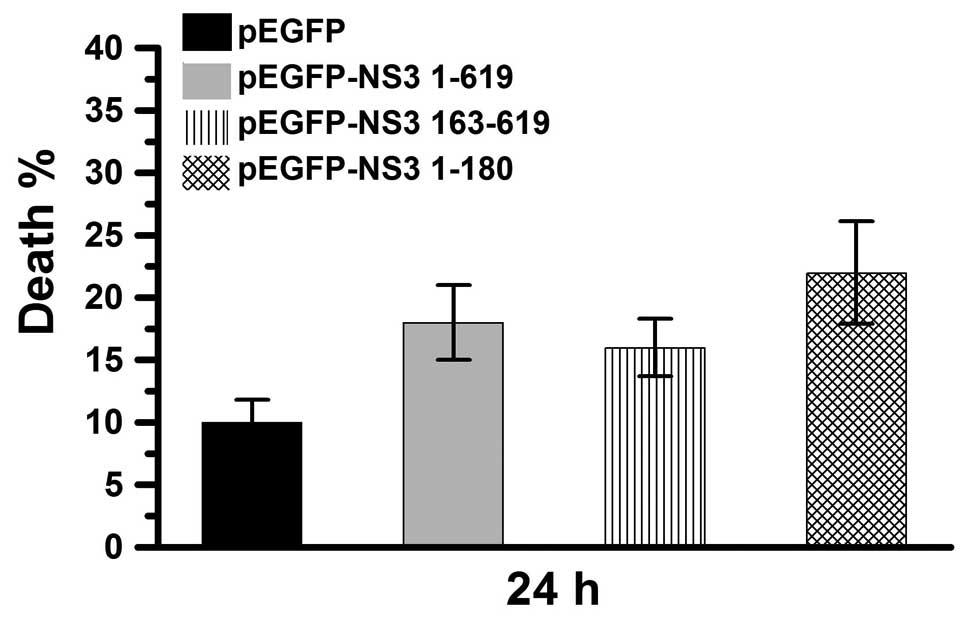|
1
|
Hall-Mendelin S, Jansen CC, Cheah WY, et
al: Culex annulirostris (Diptera: Culicidae) host feeding
patterns and Japanese encephalitis virus ecology in northern
Australia. J Med Entomol. 49:371–377. 2012. View Article : Google Scholar
|
|
2
|
Srivastava R, Kalita J, Khan MY and Misra
UK: Status of proinflammatory and anti-inflammatory cytokines in
different brain regions of a rat model of Japanese encephalitis.
Inflamm Res. 61:381–389. 2012. View Article : Google Scholar : PubMed/NCBI
|
|
3
|
Xufang Y, Huanyu W, Shihong F, et al:
Etiological spectrum of clinically diagnosed Japanese encephalitis
cases reported in Guizhou Province, China, in 2006. J Clin
Microbiol. 48:1343–1349. 2010. View Article : Google Scholar : PubMed/NCBI
|
|
4
|
Liao CL, Lin YL, Wang JJ, et al: Effect of
enforced expression of human bcl-2 on Japanese encephalitis
virus-induced apoptosis in cultured cells. J Virol. 71:5963–5971.
1997.PubMed/NCBI
|
|
5
|
Liao CL, Lin YL, Shen SC, et al:
Antiapoptotic but not antiviral function of human bcl-2 assists
establishment of Japanese encephalitis virus persistence in
cultured cells. J Virol. 72:9844–9854. 1998.PubMed/NCBI
|
|
6
|
Tung WH, Tsai HW, Lee IT, et al: Japanese
encephalitis virus induces matrix metalloproteinase-9 in rat brain
astrocytes via NF-kappaB signalling dependent on MAPKs and reactive
oxygen species. Br J Pharmacol. 161:1566–1583. 2010. View Article : Google Scholar
|
|
7
|
Yang TC, Lai CC, Shiu SL, et al: Japanese
encephalitis virus down-regulates thioredoxin and induces
ROS-mediated ASK1-ERK/p38 MAPK activation in human promonocyte
cells. Microbes Infect. 12:643–651. 2010. View Article : Google Scholar : PubMed/NCBI
|
|
8
|
Gupta N, Bhaskar AS and Lakshmana Rao PV:
Transcriptional regulation and activation of the mitogen-activated
protein kinase pathway after Japanese encephalitis virus infection
in neuroblastoma cells. FEMS Immunol Med Microbiol. 62:110–121.
2011. View Article : Google Scholar
|
|
9
|
Lee YH, Wei CW, Wang JJ and Chiou CT:
Rana catesbeiana ribonuclease inhibits Japanese encephalitis
virus (JEV) replication and enhances apoptosis of JEV-infected
BHK-21 cells. Antiviral Res. 89:193–198. 2011. View Article : Google Scholar
|
|
10
|
Tsao CH, Su HL, Lin YL, et al: Japanese
encephalitis virus infection activates caspase-8 and -9 in a
FADD-independent and mitochondrion-dependent manner. J Gen Virol.
89:1930–1941. 2008. View Article : Google Scholar : PubMed/NCBI
|
|
11
|
Markoff LJ, Innis BL, Houghten R and
Henchal LS: Development of cross-reactive antibodies to plasminogen
during the immune response to dengue virus infection. J Infect Dis.
164:294–301. 1991. View Article : Google Scholar : PubMed/NCBI
|
|
12
|
Fletcher NF and McKeating JA: Hepatitis C
virus and the brain. J Viral Hepat. 19:301–306. 2012. View Article : Google Scholar
|
|
13
|
Osorio HC, Ze-Ze L and Alves MJ:
Host-feeding patterns of Culex pipiens and other potential
mosquito vectors (Diptera: Culicidae) of West Nile virus
(Flaviviridae) collected in Portugal. J Med Entomol. 49:717–721.
2012.
|
|
14
|
Iacono-Connors LC and Schmaljohn CS:
Cloning and sequence analysis of the genes encoding the
nonstructural proteins of Langat virus and comparative analysis
with other flaviviruses. Virology. 188:875–880. 1992. View Article : Google Scholar : PubMed/NCBI
|
|
15
|
Liao H, Xu J and Huang J: FasL/Fas pathway
is involved in dengue virus induced apoptosis of the vascular
endothelial cells. J Med Virol. 82:1392–1399. 2010. View Article : Google Scholar : PubMed/NCBI
|
|
16
|
Korner C, Tolksdorf F, Riesner K, et al:
Hepatitis C coinfection enhances sensitization of CD4(+) T-cells
towards Fas-induced apoptosis in viraemic and HAART-controlled
HIV-1-positive patients. Antivir Ther. 16:1047–1055.
2011.PubMed/NCBI
|
|
17
|
Kumar M, Verma S and Nerurkar VR:
Pro-inflammatory cytokines derived from West Nile virus
(WNV)-infected SK-N-SH cells mediate neuroinflammatory markers and
neuronal death. J Neuroinflammation. 7:732010. View Article : Google Scholar : PubMed/NCBI
|
|
18
|
Prikhod’ko GG, Prikhod’ko EA, Cohen JI and
Pletnev AG: Infection with Langat Flavivirus or expression of the
envelope protein induces apoptotic cell death. Virology.
286:328–335. 2001.PubMed/NCBI
|
|
19
|
Shafee N and AbuBakar S: Dengue virus type
2 NS3 protease and NS2B-NS3 protease precursor induce apoptosis. J
Gen Virol. 84:2191–2195. 2003. View Article : Google Scholar : PubMed/NCBI
|
|
20
|
Gamlen T, Richards KH, Mankouri J, et al:
Expression of the NS3 protease of cytopathogenic bovine viral
diarrhea virus results in the induction of apoptosis but does not
block activation of the beta interferon promoter. J Gen Virol.
91:133–144. 2010. View Article : Google Scholar : PubMed/NCBI
|
|
21
|
Ramanathan MP, Chambers JA, Pankhong P, et
al: Host cell killing by the West Nile Virus NS2B-NS3 proteolytic
complex: NS3 alone is sufficient to recruit caspase-8-based
apoptotic pathway. Virology. 345:56–72. 2006. View Article : Google Scholar : PubMed/NCBI
|
|
22
|
Prikhod’ko GG, Prikhod’ko EA, Pletnev AG
and Cohen JI: Langat flavivirus protease NS3 binds caspase-8 and
induces apoptosis. J Virol. 76:5701–5710. 2002.PubMed/NCBI
|
|
23
|
Yang TC, Shiu SL, Chuang PH, et al:
Japanese encephalitis virus NS2B-NS3 protease induces caspase 3
activation and mitochondria-mediated apoptosis in human
medulloblastoma cells. Virus Res. 143:77–85. 2009. View Article : Google Scholar
|
|
24
|
Yamashita T, Unno H, Mori Y, et al:
Crystal structure of the catalytic domain of Japanese encephalitis
virus NS3 helicase/nucleoside triphosphatase at a resolution of 1.8
A. Virology. 373:426–436. 2008. View Article : Google Scholar : PubMed/NCBI
|
|
25
|
Borowski P, Heising MV, Miranda IB, Liao
CL, Choe J and Baier A: Viral NS3 helicase activity is inhibited by
peptides reproducing the Arg-rich conserved motif of the enzyme
(motif VI). Biochem Pharmacol. 76:28–38. 2008. View Article : Google Scholar : PubMed/NCBI
|
|
26
|
Lin CW, Huang HD, Shiu SY, et al:
Functional determinants of NS2B for activation of Japanese
encephalitis virus NS3 protease. Virus Res. 127:88–94. 2007.
View Article : Google Scholar : PubMed/NCBI
|
|
27
|
Utama A, Shimizu H, Morikawa S, et al:
Identification and characterization of the RNA helicase activity of
Japanese encephalitis virus NS3 protein. FEBS Lett. 465:74–78.
2000. View Article : Google Scholar : PubMed/NCBI
|
|
28
|
Bera AK, Kuhn RJ and Smith JL: Functional
characterization of cis and trans activity of the Flavivirus
NS2B-NS3 protease. J Biol Chem. 282:12883–12892. 2007. View Article : Google Scholar : PubMed/NCBI
|
|
29
|
Chang YS, Liao CL, Tsao CH, et al:
Membrane permeabilization by small hydrophobic nonstructural
proteins of Japanese encephalitis virus. J Virol. 73:6257–6264.
1999.PubMed/NCBI
|
|
30
|
Lin CW, Lin KH, Lyu PC and Chen WJ:
Japanese encephalitis virus NS2B-NS3 protease binding to
phage-displayed human brain proteins with the domain of trypsin
inhibitor and basic region leucine zipper. Virus Res. 116:106–113.
2006. View Article : Google Scholar
|
|
31
|
Haeri M, Wöllert T, Langford GM and
Gilbert JL: Electrochemical control of cell death by
reduction-induced intrinsic apoptosis and oxidation-induced
necrosis on CoCrMo alloy in vitro. Biomaterials. 33:6295–6304.
2012. View Article : Google Scholar : PubMed/NCBI
|
|
32
|
La Vignera S, Condorelli R, Vicari E,
D’Agata R and Calogero AE: Effects of varicocelectomy on sperm DNA
fragmentation, mitochondrial function, chromatin condensation and
apoptosis. J Androl. 33:389–396. 2012.PubMed/NCBI
|
|
33
|
Burattini S, Ferri P, Battistelli M, et
al: Apoptotic DNA fragmentation can be revealed in situ: an
ultrastructural approach. Microsc Res Tech. 72:913–923. 2009.
View Article : Google Scholar : PubMed/NCBI
|
|
34
|
Mu S, Tian X, Ruan Y, et al: Diosgenin
induces apoptosis in IGF-1-stimulated human thyrocytes through two
caspase-dependent pathways. Biochem Biophys Res Commun.
418:347–352. 2012. View Article : Google Scholar : PubMed/NCBI
|
|
35
|
Pan TL, Wang PW, Leu YL, Wu TH and Wu TS:
Inhibitory effects of Scutellaria baicalensis extract on
hepatic stellate cells through inducing G2/M cell cycle arrest and
activating ERK-dependent apoptosis via Bax and caspase pathway. J
Ethnopharmacol. 139:829–837. 2012.
|
|
36
|
Lee CS, Kwak SW, Kim YJ, et al: Guanylate
cyclase activator YC-1 potentiates apoptotic effect of licochalcone
A on human epithelial ovarian carcinoma cells via activation of
death receptor and mitochondrial pathways. Eur J Pharmacol.
683:54–62. 2012. View Article : Google Scholar
|
|
37
|
Yang C, Liu HZ and Fu ZX: PEG-liposomal
oxaliplatin induces apoptosis in human colorectal cancer cells via
Fas/FasL and caspase-8. Cell Biol Int. 36:289–296. 2012. View Article : Google Scholar : PubMed/NCBI
|
|
38
|
Hua YY, Wang XS, Zhang Y, Yao CG, Zhang XM
and Xiong ZA: Intense picosecond pulsed electric fields induce
apoptosis through a mitochondrial-mediated pathway in HeLa cells.
Mol Med Rep. 5:981–987. 2012.PubMed/NCBI
|
|
39
|
Yiang GT, Yu YL, Chou PL, et al: The
cytotoxic protein can induce autophagocytosis in addition to
apoptosis in MCF-7 human breast cancer cells. In Vivo. 26:403–409.
2012.PubMed/NCBI
|
|
40
|
Tang CH, Hu CC, Wei CW and Wang JJ:
Synergism of Rana catesbeiana ribonuclease and IFN-gamma
triggers distinct death machineries in different human cancer
cells. FEBS Lett. 579:265–270. 2005.PubMed/NCBI
|
|
41
|
Lee CJ, Liao CL and Lin YL: Flavivirus
activates phosphatidylinositol 3-kinase signaling to block
caspase-dependent apoptotic cell death at the early stage of virus
infection. J Virol. 79:8388–8399. 2005. View Article : Google Scholar : PubMed/NCBI
|
|
42
|
Deng X, Shi Z, Li S, et al:
Characterization of nonstructural protein 3 of a neurovirulent
Japanese encephalitis virus strain isolated from a pig. Virol J.
8:2092011. View Article : Google Scholar : PubMed/NCBI
|
|
43
|
Kaczor A and Matosiuk D: Structure-based
virtual screening for novel inhibitors of Japanese encephalitis
virus NS3 helicase/nucleoside triphosphatase. FEMS Immunol Med
Microbiol. 58:91–101. 2010. View Article : Google Scholar : PubMed/NCBI
|
|
44
|
Wei CW, Hu CC, Tang CH, Lee MC and Wang
JJ: Induction of differentiation rescues HL-60 cells from Rana
catesbeiana ribonuclease-induced cell death. FEBS Lett.
531:421–426. 2002. View Article : Google Scholar : PubMed/NCBI
|
|
45
|
Yu HY, Jin CY, Kim KS, et al:
Oleifolioside A mediates caspase-independent human cervical
carcinoma HeLa cell apoptosis involving nuclear relocation of
mitochondrial apoptogenic factors AIF and EndoG. J Agric Food Chem.
60:5400–5406. 2012. View Article : Google Scholar
|
|
46
|
Jang EH, Park CS and Kang JH: Bupropion,
an atypical antidepressant, induces endoplasmic reticulum stress
and caspase-dependent cytotoxicity in SH-SY5Y cells. Toxicology.
285:1–7. 2011. View Article : Google Scholar : PubMed/NCBI
|
|
47
|
Zhi B, Tang W and Zhang X: Enhancement of
shrimp antiviral immune response through caspase-dependent
apoptosis by small molecules. Mar Biotechnol (NY). 13:575–583.
2011. View Article : Google Scholar : PubMed/NCBI
|
|
48
|
Linsenbardt AJ, Breckenridge JM, Wilken GH
and Macarthur H: Dopaminochrome induces caspase-independent
apoptosis in the mesencephalic cell line, MN9D. J Neurochem.
122:175–184. 2012. View Article : Google Scholar : PubMed/NCBI
|
|
49
|
Furre IE, Møller MT, Shahzidi S, Nesland
JM and Peng Q: Involvement of both caspase-dependent and
-independent pathways in apoptotic induction by
hexaminolevulinate-mediated photodynamic therapy in human lymphoma
cells. Apoptosis. 11:2031–2042. 2006. View Article : Google Scholar
|
|
50
|
Cho BO, Jin CH, Park YD, et al:
Isoegomaketone induces apoptosis through caspase-dependent and
caspase-independent pathways in human DLD1 cells. Biosci Biotechnol
Biochem. 75:1306–1311. 2011. View Article : Google Scholar : PubMed/NCBI
|
|
51
|
Yoo JO, Lim YC, Kim YM and Ha KS:
Transglutaminase 2 promotes both caspase-dependent and
caspase-independent apoptotic cell death via the calpain/Bax
protein signaling pathway. J Biol Chem. 287:14377–14388. 2012.
View Article : Google Scholar : PubMed/NCBI
|
|
52
|
Su ZY, Tung YC, Hwang LS and Sheen LY:
Blazeispirol A from Agaricus blazei fermentation product
induces cell death in human hepatoma Hep 3B cells through
caspase-dependent and caspase-independent pathways. J Agric Food
Chem. 59:5109–5116. 2011.PubMed/NCBI
|














